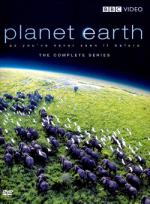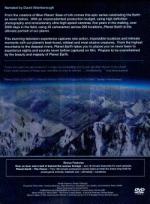|
Planet Earth: The Complete Series: Disc 3
|
| UPC: |
Disc: 7BAC-3EEE-330D-4211 (DVD)
|
| Region
Coding: |
Region 1
|
| Production
Year: |
2006
|
| Rating: |
NR
|
| Running
Time: |
175 min.
|
| DVD
Release: |
4/24/2007
|
| Case
Type: |
Digipak
|
| Video
Formats: |
Anamorphic Widescreen 1.78:1 |
| Disc
Formats: |
Single Sided, Dual Layered
|
| SRP: |
$0.00
|
7. "Great Plains"
Originally transmitted: 12 November 2006 (UK), 8 April 2007 (US)
This episode deals with savanna, steppe, tundra, prairie, and looks at the importance and resilience of grasses in such treeless ecosystems. Their vast expanses contain the largest concentration of animal life. In Outer Mongolia, a herd of Mongolian gazelle flee a bush fire and has to move on to new grazing, but grass can repair itself rapidly and soon reappears. On the Arctic tundra during spring, millions of migratory snow geese arrive to breed and their young are preyed on by Arctic foxes. Meanwhile, time-lapse photography depicts moving herds of caribou as a calf is brought down by a chasing wolf. On the North American prairie, bison engage in the ritual to establish the dominant males. The Tibetan Plateau is the highest of the plains and despite its relative lack of grass, animals do survive there, including yak and wild ass. However, the area's most numerous resident is the pika, whose nemesis is the Tibetan fox. In tropical India, the tall grasses hide some of the largest creatures and also the smallest, such as the pygmy hog. The final sequence depicts the African savannah and elephants that are forced to share a waterhole with a pride of thirty lions. The insufficient water makes it an uneasy alliance and the latter gain the upper hand during the night when their hunger drives them to hunt and eventually kill one of the pachyderms. Planet Earth Diaries explains how the lion hunt was filmed in darkness using infrared light.
8. "Jungles"
Originally transmitted: 19 November 2006 (UK), 15 April 2007 (US)
The next instalment examines jungles and tropical rainforests. These environments occupy only 3% of the land yet are home to over half of the world's species. New Guinea is inhabited by almost 40 kinds of birds of paradise, which avoid conflict with each other by living in different parts of the island. Some of their elaborate courtship displays are shown. Within the dense forest canopy, sunlight is prized, and the death of a tree triggers a race by saplings to fill the vacant space. Figs are a widespread and popular food, and as many as 44 types of bird and monkey have been observed picking from a single tree. The sounds of the jungle throughout the day are explored, from the early morning calls of siamangs and orangutans to the nocturnal cacophony of courting tree frogs. The importance of fungi to the rainforest is illustrated by a sequence of them fruiting, including a parasite called cordyceps. The mutual benefits of the relationship between carnivorous pitcher plants and red crab spiders is also discussed. In the Congo, roaming forest elephants are shown reaching a clearing to feed on essential clay minerals within the mud. Finally, chimpanzees are one of the few jungle animals able to traverse both the forest floor and the canopy in search of food. In Uganda, members of a 150-strong community of the primates mount a raid into neighbouring territory in order to gain control of it. Planet Earth Diaries looks at filming displaying birds of paradise.
9. "Shallow Seas"
Originally transmitted: 26 November 2006 (UK), 8 April 2007 (US)
This programme is devoted to the shallow seas that fringe the world's continents. Although they constitute 8% of the oceans, they contain most marine life. As humpback whales return to breeding grounds in the tropics, a mother and its calf are followed. While the latter takes in up to 500 litres of milk a day, its parent will starve until it travels back to the poles to feed — and it must do this while it still has sufficient energy left for the journey. The coral reefs of Indonesia are home to the biggest variety of ocean dwellers. Examples include banded sea kraits, which ally themselves with goatfish and trevally in order to hunt. In Western Australia, dolphins 'hydroplane' in the shallowest waters to catch a meal, while in Bahrain, 100,000 Socotra cormorants rely on shamals that blow sand grains into the nearby Persian Gulf, transforming it into a rich fishing ground. The appearance of algae in the spring starts a food chain that leads to an abundant harvest, and sea lions and dusky dolphins are among those taking advantage of it. In Southern Africa, as chokka squid are preyed on by short-tail stingray, the Cape fur seals that share the waters are hunted by the world's largest predatory fish: the great white shark. On Marion Island in the Indian Ocean, a group of king penguins must cross a beach occupied by fur seals that do not hesitate to attack them. Planet Earth Diaries shows the difficulties of filming the one-second strike of a great white shark.
|
|
|

 |
| Genres |
Documentary
Television
|
|
| Studios |
BBC Video
Discovery Channel
Media Companies: BBC Home Video
|
|
|
|
|
| Subtitles |
English
French
Spanish
|
|
|
| Audio
Tracks |
English Dolby Digital 5.1
|
|
| Cast |
Great Plains
David Attenborough as Narrator (voice)
Jungles
David Attenborough as Narrator (voice)
Shallow Seas
David Attenborough as Narrator (voice) |
|
| Crew |
7. Great Plains
Production:
Jonny Keeling: Producer
Alastair Fothergill: Producer
Cinematography:
Richard Burton: Cinematographer
Martyn Colbeck: Cinematographer
Justine Evans: Cinematographer
Mike Holding: Cinematographer
Michael Kelem: Cinematographer
Ian McCarthy: Cinematographer
Justin Maguire: Cinematographer
Shane Moore: Cinematographer
Toshihiro Muta: Cinematographer
Mark Payne-Gill: Cinematographer
Tim Shepherd: Cinematographer
Mark Smith: Cinematographer
Jeff Turner: Cinematographer
Nick Turner: Cinematographer
John Waters: Cinematographer
Film Editing:
Tim Coope: Film Editor
Music:
George Fenton: Composer
Sound:
Kate Hopkins: Sound Editor
Andrew Wilson: Sound Re-Recording Mixer
8. Jungles
Production:
Huw Cordey: Producer
Alastair Fothergill: Producer
Cinematography:
Tony Allen: Cinematographer
Barrie Britton: Cinematographer
Gordon Buchanan: Cinematographer
Martyn Colbeck: Cinematographer
Justine Evans: Cinematographer
Ted Giffords: Cinematographer
Michael Kelem: Cinematographer
Alastair MacEwen: Cinematographer
Justin Maguire: Cinematographer
Jamie McPherson: Cinematographer
Tim Shepherd: Cinematographer
Paul Stewart: Cinematographer
Bill Wallauer: Cinematographer
Film Editing:
Dave Pearce: Film Editor
Music:
George Fenton: Composer
Sound:
Tim Owens: Sound Editor
Ben Peace: Sound Editor
Andrew Wilson: Sound Re-Recording Mixer
9. Shallow Seas
Production:
Mark Brownlow: Producer
Alastair Fothergill: Producer
Cinematography:
Doug Allan: Cinematographer
Doug Anderson: Cinematographer
Paul Atkins: Cinematographer
Richard Burton: Cinematographer
Leighton de Barros: Cinematographer
Bob Cranston: Cinematographer
Simon King: Cinematographer
Peter Kragh: Cinematographer
Ian McCarthy: Cinematographer
Didier Noirot: Cinematographer
Mark Payne-Gill: Cinematographer
Andrew Penniket: Cinematographer
Mike Potts: Cinematographer
Peter Scoones: Cinematographer
Gavin Thurston: Cinematographer
Film Editing:
Stuart Napier: Film Editor
Music:
George Fenton: Composer
Sound:
Kate Hopkins: Sound Editor
Graham Wild: Sound Re-Recording Mixer
|
|
|
|